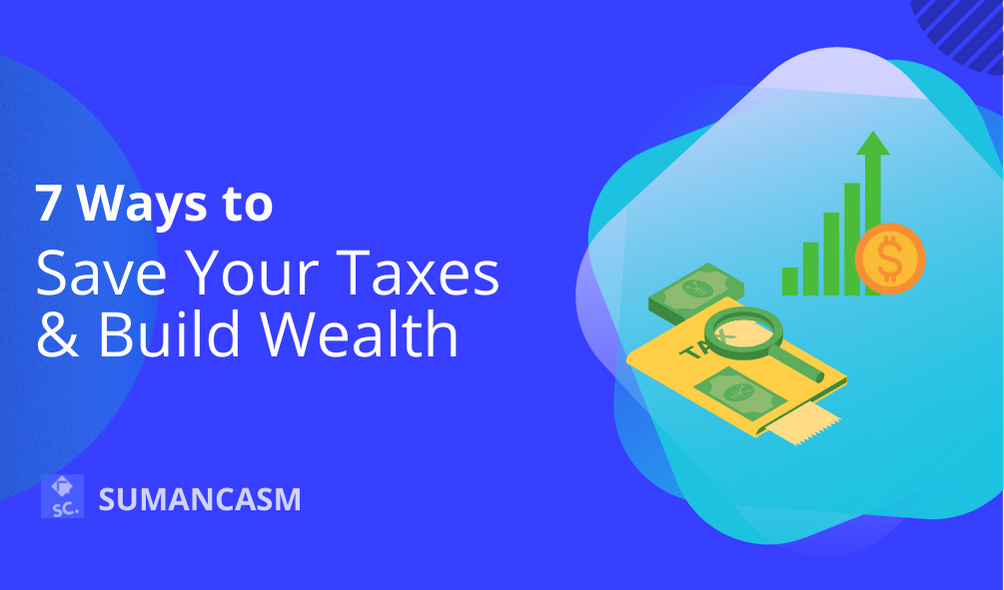If you are the one who doesn’t any clue about how to save your taxes, well you are right at the right place at the right time.
It doesn’t matter if you are trying to save the maximum taxes before the end of March or during the rest of the year.
Saving taxes takes just a little effort and patience. No worries, if you are running out of patience or do not want to invest time in doing some more research, I am here to help you out.
We will simply try to keep this article very simple and how much taxes you can save. I will share an example at the end that will help understand taxes in a very simple manner. Read along.

Let’s quickly understand the various sections under which you can save taxes:
1. Saving taxes under Section 80C
You can make an investment of Rs. 1.5 lakh u/s(under Section) 80C to reduce your taxable income. An additional deduction of Rs 50,000 can be claimed by investing in NPS under 80CCD
Investing under Tax saving instruments like ELSS funds provides a great upside in these market conditions. They have a lock-in period of 3 years before which you cannot withdraw your money.
Basically, investing via SIP in such instruments provides a great opportunity and lesser stress at the end of the financial year.
The following investment instruments can help with the tax deduction under Section 80C of the Income Tax Act, 1961:
- National Savings Certificate(NSC)
- PPF(Public Provident Fund)
- Sukanya Samriddhi Yojana (SSY)
- Life Insurance
- ELSS Mutual Funds
- Pension Fund
- 5 years Bank Fixed Deposits
- 5 years Post Office Deposits
The interest earned on the withdrawals of equity funds are taxable under Long Term Capital Gains known as LTCG. The Long-term capital gains over Rs 1 lakh on listed equity shares per financial year is taxaable at the rate of 10%
Let’s say you earn 1 lakh interest on the equity investments you are supposed to pay 10,000 as LTCG.
2. Save your Taxes under 80D
You can buy medical Insurance, here the maximum deduction allowed is 1 lakh for self and family under Sec 80D
Under 80D: Maximum deduction allowed can vary as per the following methods:
- Individuals can claim a maximum deduction of Rs. 25000 for insurance premiums for self, spouse, or dependent children.
- Individuals can claim a maximum deduction of up to Rs 50,000 including premium for self, spouse, dependent children, and dependent parents below 60 years of age.
- While Individuals can claim a maximum deduction of up to Rs. 75,000 including premium for self, spouse, children, and dependent parents above 60 years of age.
- Furthermore, an individual can claim Rs 1,00,000 as a maximum deduction if an individual is above 60 years of age and makes the payment for self, spouse, dependent children, and dependent parents above 60 years of age.
Now, based on your tax bracket.
Let’s say Rajat has an income of 12 LPA, he will be taxed under the 30% tax bracket.
And he pays a premium for his family including his spouse and children amounting to Rs 15,000 and 33,000 for his Mother who is above 60 years of age.
Here, Rajat can claim 15,000 + 33,000 = 48,000 for the Tax deduction.
Next, as per his Tax bracket: 30% of 48,000 = 14,400 + 4% Cess: 15,000 is the total tax savings!
Similarly, you will need to calculate your tax savings as per the investment.
3. Save your Taxes with HRA exemption/Who can claim the same?
Salaried employees who receive house rent allowance as a part of salary and make a payment towards rent can claim HRA exemption to reduce their taxable salary completely or partially.
Calculation:
HRA exemption is allowed in one of the cases:
- Actual HRA received by the employee
- 40% of salary for non-metro cities or 50% of salary if the property is rented in Metro cities like Mumbai, Delhi, Kolkata, Chennai
- Lastly, if the actual rent paid less than 10% of salary
4. Save your Taxes through Home Loan
Claim deduction of up to Rs. 50,000 on Home Loan Interest u/s(under Section) 80EE
If you have taken a Home Loan, you are allowed to claim a deduction for repayment of the principal amount of the home loan u/s(under section) 80C.
Moreover, you are also allowed to claim a deduction of interest paid on a home loan under section 24. The maximum deduction that is permitted in some cases is Rs. 2,00,000 and in some cases, there is no maximum limit for claiming this deduction for payment of interest on the home loan.
5. Save your Taxes through Education Loan u/s 80E
If a taxpayer has taken an education loan for the higher education of himself or his spouse or children or the student of whom he is the legal guardian, he can claim a deduction u/s(under section) 80E and save taxes.
6. Standard Deduction
If you are a salaried employee you can enjoy a rejoice as you are given a standard deduction with a limit of Rs 50,000 applicable for all salaried taxpayers.
7. Save Taxes with Donations u/s 80G
If a taxpayer makes a donation for charity, social or philanthropic purposes or makes a contribution towards National Relief Fund, then this donation can be claimed as a deduction u/s 80G of the Income Tax Act.
Bonus Content:
Which is more benefinal Old or New Tax Regime? 🤔
The Budget 2020-21 introduced an optional tax regime. Each year you have the choice to go with the old or new tax regime.
Following are the ways in which the new tax regime can help you:
- It has lower tax rates, at least 5% less
- It does not allow most of the exemptions listed above
More details here in this article.
What are Financial Year and Assessment Year? 😀
In simplest terms, Financial Year(FY) is the year in which the income is earned. The period in which the income is earned is known as the Financial year.
The income tax returns are filed and taxes for a company or individual is usually paid in the next year after the end of the financial year. The next year in which your income will be assessed for tax is called the Assessment Year (AY).
Note: The assessment year (AY) is the year that comes after the FY. This is the time in which the income earned during FY is assessed and taxed. Both FY and AY start on 1 April and end on 31 March. For instance, for FY 2020-21, the assessment year is AY 2021-22.
Here’s an example: For the Year starting 1st April 2019 and ending on 31st March 2020, the period is called the Financial Year 2019-2020. And the income earned in this FY would be assessed to tax in the next year which is the assessment year 2020-2021.
Goodbye, until next time. This is Suman signing off guys! Would you like to read more from me? Visit my Blog for Lifestyle Tips and also Blogging Tips.
Also, looking for some easy tips, tricks, and everyday motivation, do follow my Facebook, and Instagram pages. You can find me on Pinterest too. 📌




